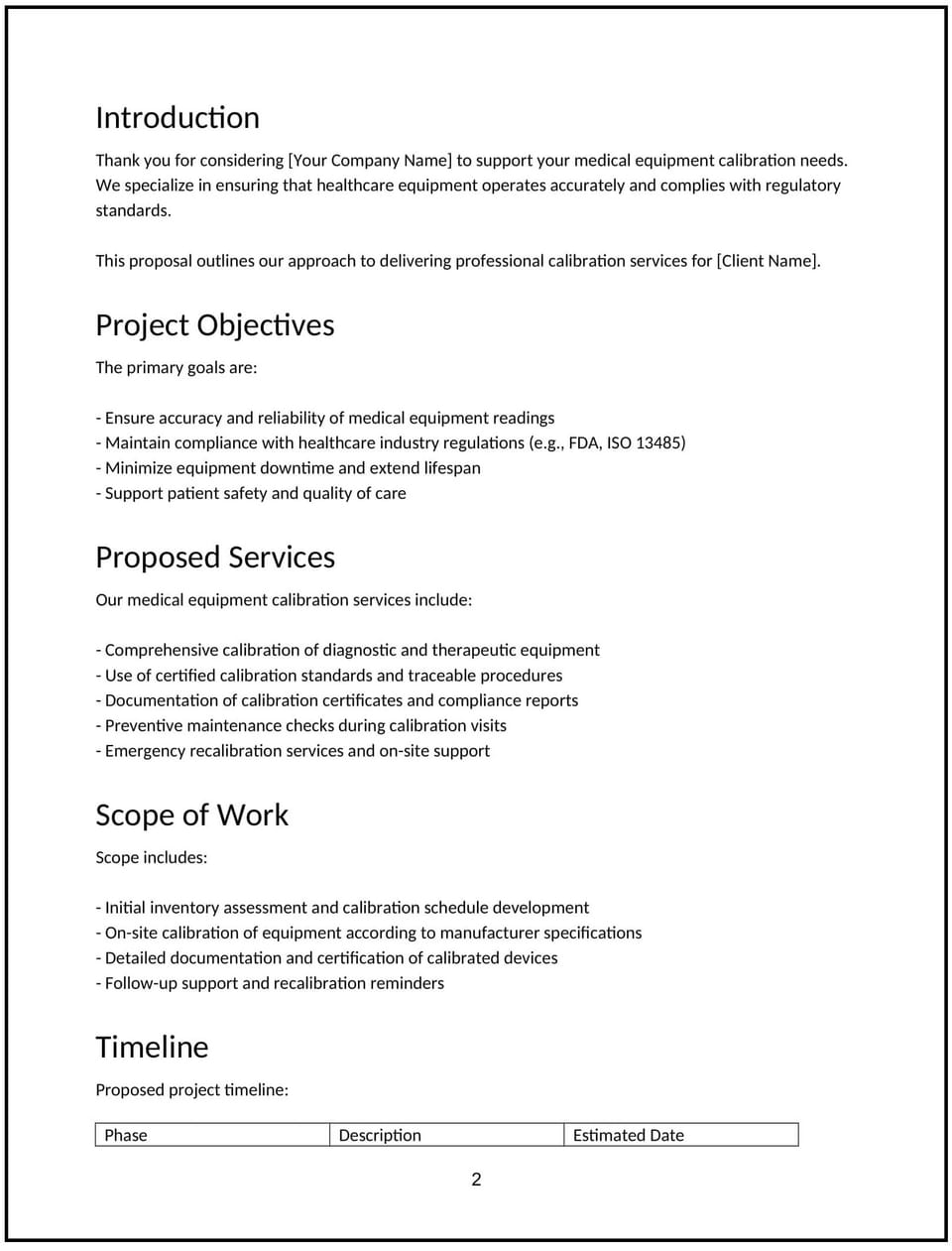Medical-equipment calibration proposal: Free template

Customize this free medical-equipment calibration proposal with Cobrief
Open this free medical-equipment calibration proposal in Cobrief and start editing it instantly using AI. You can adjust the tone, structure, and content based on the equipment types, facility needs, and compliance requirements. You can also use AI to review your draft — spot gaps, tighten language, and improve clarity before sending.
Once you're done, send, download, or save the proposal in one click — no formatting or setup required.
This template is fully customizable and built for real-world use — ideal for pitching calibration services to hospitals, outpatient clinics, diagnostic labs, or private practices. Whether you're offering one-time calibration or long-term service contracts, this version gives you a structured head start and removes the guesswork.
What is a medical-equipment calibration proposal?
A medical-equipment calibration proposal outlines your plan to inspect, test, and adjust medical devices to ensure they meet accuracy standards. It typically includes the list of equipment covered, calibration procedures, documentation process, compliance alignment, and pricing.
This type of proposal is commonly used:
- When facilities need to maintain compliance with regulatory standards (e.g., FDA, ISO, CAP)
- Before audits, inspections, or equipment certification deadlines
- When onboarding a new service vendor or renewing calibration schedules
It helps ensure that critical devices — from diagnostic tools to life-support machines — are functioning properly and producing reliable results.
A strong proposal helps you:
- Show the client you understand their specific equipment and compliance environment
- Clearly define your process, schedule, and documentation
- Build trust with proof of accuracy, traceability, and qualified technicians
- Prevent operational risk from inaccurate or non-compliant devices
Why use Cobrief to edit your proposal
Cobrief helps you produce clear, structured proposals faster — with AI tools that simplify edits and reduce back-and-forth.
- Edit the proposal directly in your browser: No formatting issues or templates to download — just open and start writing.
- Rewrite sections with AI: Instantly tailor your message for clinical directors, facility managers, or compliance officers.
- Run a one-click AI review: Let AI catch vague descriptions, unclear service scope, or missing compliance notes.
- Apply AI suggestions instantly: Accept changes line by line or apply them all at once.
- Share or export instantly: Send your proposal through Cobrief or download a clean PDF or DOCX version for review.
You’ll get from draft to delivery faster — with more clarity and less hassle.
When to use this proposal
Use this medical-equipment calibration proposal when:
- Quoting one-time or recurring calibration services for medical or lab devices
- Responding to a compliance-driven RFP or internal audit requirement
- Offering calibration as part of broader biomedical equipment servicing
- Working with facilities preparing for CAP, FDA, or ISO inspections
- Replacing a previous vendor or consolidating services across locations
It’s especially useful when equipment accuracy is mission-critical and documentation is a regulatory requirement.
What to include in a medical-equipment calibration proposal
Use this template to clearly explain what equipment you’ll service, how calibration is done, and how results will be tracked.
- Project overview: Describe the client’s calibration need — such as meeting regulatory requirements or preparing for inspection — and how your team supports that goal.
- Equipment covered: List the types of equipment included — such as infusion pumps, defibrillators, EKG machines, thermometers, centrifuges, or diagnostic tools.
- Calibration process: Explain how each device will be tested, adjusted, and validated against manufacturer or regulatory standards.
- Certification and documentation: Describe what records you’ll provide — calibration certificates, test results, tolerances, and traceability data.
- Compliance alignment: Clarify which standards your services meet (e.g., NIST, ISO 17025, CAP, FDA) and how those align with client requirements.
- Scheduling and logistics: Outline how and when the work will be performed — onsite or offsite, in one visit or in phases, during or after hours.
- Technician qualifications: Mention your team’s training, certifications, and experience with specific device types or brands.
- Pricing: Present your structure — flat rate per unit, bundled service packages, or per-visit rates. Include optional retainer plans or emergency services if offered.
- Next steps: End with a clear CTA — such as approving the quote, scheduling a walkthrough, or signing a service agreement.
How to write an effective medical-equipment calibration proposal
This proposal should feel precise, reliable, and audit-ready — especially for facility managers and compliance teams under regulatory pressure.
- Lead with compliance and confidence: Focus on how your services reduce risk and meet inspection requirements.
- Tailor your scope: Customize the equipment list and testing process for each facility’s environment.
- Highlight traceability and accuracy: Reinforce how your documentation supports legal and clinical accountability.
- Keep language accessible: Avoid unnecessary technical jargon, especially for administrative readers.
- Build trust with process clarity: Be transparent about turnaround time, disruption, and technician experience.
- Always close with one step forward: Help the client act without delay — don’t leave the process open-ended.
Frequently asked questions (FAQs)
Can I reuse this proposal for different types of facilities?
Yes — just update the equipment list, scheduling preferences, and regulatory context for hospitals, clinics, or labs.
Does this proposal include repairs or maintenance?
Only if specified. You can offer basic troubleshooting or full-service plans as an add-on to calibration.
What if the client wants annual or recurring calibrations?
You can include a retainer or service schedule as part of the proposal or offer it as an ongoing engagement option.
Is this proposal a legally binding agreement?
No — it outlines your scope, pricing, and process. A separate service contract can be attached or signed if needed.
This article contains general legal information and does not contain legal advice. Cobrief is not a law firm or a substitute for an attorney or law firm. The law is complex and changes often. For legal advice, please ask a lawyer.